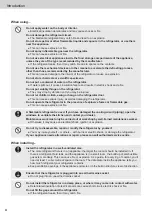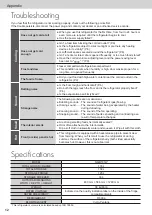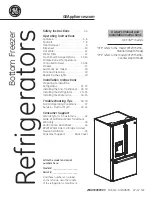
4
Introduction
When using...
Do not apply water on the body or interior.
● Electrical insulation deteriorates and may cause shocks or fire.
Do not damage the refrigerant circuit.
● The flammable refrigerant may catch fire and lead to an explosion.
Do not store petrol or other flammable liquids and vapours in the refrigerator, or use them
near the appliance.
● This can cause explosion or fire.
Do not spray inflammable gas near the refrigerator.
● This can cause explosion or fire.
Do not use electrical appliances inside the food storage compartments of the appliance,
unless they are of the type recommended by the manufacturer.
● If the refrigerant leaks, then it may catch fire due to sparks on the contacts.
Do not use the mechanical devices or other means to accelerate the defrosting process,
other than those recommended by the manufacturer.
● This can cause damage to the interior of the refrigerator or cause an explosion.
Do not store chemicals or scientific specimens.
Do not put a container of water on the refrigerator.
● If water spills out, it causes insulation failure and results in electric shock and a fire.
Do not put wobbly things on the refrigerator.
● They may drop by vibration and you may be injured.
Do not let children climb, swing or hang on the refrigerator door.
● This can cause serious injury, as well as damaging the refrigerator.
Do not operate the refrigerator in the presence of explosive fumes or flammable gas.
● This can cause explosion or fire.
A flammable refrigerant is used. If you have damaged the cooling circuit (piping), open the
windows to ventilate the kitchen and contact your dealer.
Maintenance work must only be carried out at workshop by well-trained maintenance worker.
● Otherwise it may cause an electrical shock, ignition or explosion.
Do not try to disassemble, repair or modify the refrigerator by yourself.
● You may injure yourself – or others – with burns or electric shock, or damage the refrigerator.
If your appliance needs alterations or repair, please consult authorized service centre.
When installing...
Install the refrigerator in a well-ventilated area.
● The more refrigerant there is in an appliance, the larger the room it should be installed in. If
there’s a refrigerant fluid leak, and the appliance is in a small room, the build up of combustible
gases is more likely. This can cause fire or explosion. As a guide, for every 8 g of coolant, you’ll
need at least 1 cubic metre of space in the room. The data plate inside the appliance tells you
how much refrigerant your refrigerator contains.
● Keep ventilation openings, in the appliance enclosure or in the built-in structure, clear of obstruction.
Ensure that the refrigerator is plugged into an earthed mains socket.
● Do not plug into an unearthed mains socket.
Do not install the refrigerator in a damp place, or where it may come into contact with water.
● Deteriorated insulation of electrical parts can cause short circuit, electric shock or fire.
Do not fill the gaps around the refrigerator.
● If the refrigerant leaks, then it may catch fire.





































